From Island Biogeography to Conservation: A Multi-Taxon and Multi-Taxonomic Rank Approach in the Tuscan Archipelago
Abstract
1. Introduction
2. Materials and Methods
2.1. Study Area
2.2. Animal and Plant Dataset, Habitat and Island Geometric Characteristics
2.3. Statistical Analyses
3. Results
4. Discussion
5. Conclusions
- (1)
- To preserve small and/or rare but relevant habitats, that are more prone to disappear in small islands, imperiling localized or low-density species linked to these habitats (driver: island area);
- (2)
- To maintain insular habitat diversity (driver: habitat diversity);
- (3)
- To protect local populations, thus counteracting the “isolation” effect among islands (driver: distance).
Author Contributions
Funding
Data Availability Statement
Acknowledgments
Conflicts of Interest
References
- Gulick, A. Biological peculiarities of oceanic islands. Q. Rev. Biol. 1932, 7, 405–427. [Google Scholar] [CrossRef]
- Greuter, W. Origin and peculiarities of Mediterranean island floras. Ecol. Mediterr. 1995, 21, 1–10. [Google Scholar] [CrossRef]
- Kier, G.; Kreft, H.; Lee, T.M.; Jetz, W.; Ibisch, P.L.; Nowicki, C.; Mutke, J.; Barthlott, W. A global assessment of endemism and species richness across island and mainland regions. Proc. Natl. Acad. Sci. USA 2009, 106, 9322–9327. [Google Scholar] [CrossRef] [PubMed]
- Brüniche-Olsen, A.; Kellner, K.F.; DeWoody, J.A. Island area, body size and demographic history shape genomic diversity in Darwin’s finches and related tanagers. Mol. Ecol. 2019, 28, 4914–4925. [Google Scholar] [CrossRef] [PubMed]
- Paulay, G. Biodiversity on oceanic islands: Its origin and extinction 1. Am. Zool. 1994, 34, 134–144. [Google Scholar] [CrossRef]
- Russell, J.C.; Kueffer, C. Island biodiversity in the Anthropocene. Annu. Rev. Environ. Resour. 2019, 44, 31–60. [Google Scholar] [CrossRef]
- Arrhenius, O. Species and area. J. Ecol. 1921, 9, 95–99. [Google Scholar] [CrossRef]
- Schoener, T.W. The species-area relation within archipelagos: Models and evidence from island land birds. In Proceedings of the 16th International Ornithological Congress, Canberra, Australia, 12–17 August 1974; Firth, J.J., Calaby, J.H., Eds.; Australian Academy of Science: Canberra, Australia, 1976; pp. 629–642. [Google Scholar]
- Triantis, K.A.; Guilhaumon, F.; Whittaker, R.J. The island species–area relationship: Biology and statistics. J. Biogeogr. 2012, 39, 215–231. [Google Scholar] [CrossRef]
- Munroe, E.G. The geographical distribution of butterflies in the West Indies. Ph.D. Thesis, Cornell University, Ithaca, NY, USA, 1948. [Google Scholar]
- Preston, F.W. The canonical distribution of commonness and rarity: Part I. Ecology 1962, 43, 185–215. [Google Scholar] [CrossRef]
- MacArthur, R.H.; Wilson, E.O. An equilibrium theory of insular zoogeography. Evolution 1963, 17, 373–387. [Google Scholar] [CrossRef]
- MacArthur, R.H.; Wilson, E.O. The Theory of Island Biogeography; Princeton University Press: Princeton, NJ, USA, 1967; pp. 1–205. [Google Scholar]
- Coleman, B.D. On random placement and species-area relations. Math. Biosci. 1981, 54, 191–215. [Google Scholar] [CrossRef]
- Coleman, B.D.; Mares, M.A.; Willig, M.R.; Hsieh, Y.H. Randomness, area, and species richness. Ecology 1982, 63, 1121–1133. [Google Scholar] [CrossRef]
- Williams, C.B. Area and number of species. Nature 1943, 152, 264–267. [Google Scholar] [CrossRef]
- McGuinness, K.A. Species–area curves. Biol. Rev. 1984, 59, 423–440. [Google Scholar] [CrossRef]
- Gotelli, N.J. A Primer of Ecology; Sinauer Associates: Sunderland, MA, USA, 2008. [Google Scholar]
- Mittermeier, R.A.; Gil, P.R.; Hoffman, M.; Pilgrim, J.; Brooks, T.; Mittermeier, C.G.; Lamoreux, J.; Da Fonseca, G.A.B. Hotspots Revisited; University of Chicago Press: Chicago, IL, USA, 2005; pp. 1–395. [Google Scholar]
- Aringoli, D.; Coltorti, M.; D’Orefice, M.; Dramis, F.; Federici, P.R.; Foresi, L.M.; Graciotti, R.; Iotti, A.; Molin, P.; Moretti, S.; et al. Carta Geomorfologica dell’Arcipelago Toscano; Memorie Descrittive della Carta Geologica d’Italia; ISPRA: Rome, Italy, 2009; Volume 86, pp. 1–107. [Google Scholar]
- Rapetti, L. 3—Lineamenti climatici dell’Arcipelago Toscano. In Carta Geomorfologica dell’Arcipelago Toscano; Aringoli, D., Coltorti, M., D’Orefice, M., Dramis, F., Federici, P.R., Foresi, L.M., Graciotti, R., Iotti, A., Molin, P., Moretti, S., et al., Eds.; Memorie Descrittive della Carta Geologica d’Italia; ISPRA: Rome, Italy, 2009; Volume 86, pp. 11–21. [Google Scholar]
- Peccerillo, A. Cenozoic volcanism in the Tyrrhenian Sea Region. In Advances in Volcanology, 2nd ed.; Nemeth, K., Ed.; Springer International Publishing: Cham, Switzerland, 2017; pp. 1–143. [Google Scholar] [CrossRef]
- Dapporto, L.; Cini, A. Faunal patterns in the Tuscan archipelago butterflies: The dominant influence is recent geography not paleogeography. Eur. J. Entomol. 2007, 104, 497–503. [Google Scholar] [CrossRef]
- Fattorini, S. Both Recent and Pleistocene geography determine animal distributional patterns in the Tuscan Archipelago. J. Zool. 2009, 277, 291–301. [Google Scholar] [CrossRef]
- Lazzaro, L.; Ferretti, G.; Giuliani, C.; Foggi, B. A checklist of the alien flora of the Tuscan Archipelago (Italy). Webbia 2014, 69, 157–176. [Google Scholar] [CrossRef]
- Ruzzier, E.; Menchetti, M.; Bortolotti, L.; Selis, M.; Monterastelli, E.; Forbicioni, L. Updated distribution of the invasive Megachile sculpturalis (Hymenoptera: Megachilidae) in Italy and its first record on a Mediterranean island. Biodivers. Data J. 2020, 8, 1–18. [Google Scholar] [CrossRef]
- Rocchi, S.; Terzani, F.; Cianferoni, F.; Forbicioni, L. Materiali per una Fauna Dell’arcipelago Toscano. XXXI. Contributo alla Conoscenza Della Coleotterofauna Acquatica Dell’arcipelago Toscano (Coleoptera). Ann. Mus. Civ. Stor. Nat. Giacomo Doria 2014, 106, 1–74. [Google Scholar]
- Tellini Florenzano, G.; Baccetti, N.; Arcamone, E.; Meschini, E.; Sposimo, E.P. Atlante degli Uccelli Nidificanti in e Svernanti in Toscana (1982–1992); Museo di Storia Naturale di Livorno: Livorno, Italy, 1997; pp. 1–414. [Google Scholar]
- Ceccolini, F.; Terzani, F.; Forbicioni, L. Vesperidae e Cerambycidae dell’arcipelago toscano: Sintesi delle conoscenze e nuovi dati. Onychium 2012, 9, 81–97. [Google Scholar]
- Fattorini, S.; Borges, P.A.; Dapporto, L.; Strona, G. What can the parameters of the species–area relationship (SAR) tell us? Insights from Mediterranean islands. J. Biogeogr. 2017, 44, 1018–1028. [Google Scholar] [CrossRef]
- Dapporto, L.; Wolf, H.; Strumia, F. Recent geography determines the distribution of some flying Hymenoptera in the Tuscan Archipelago. J. Zool. 2006, 242, 37–44. [Google Scholar] [CrossRef]
- Forbicioni, L.; Abbazzi, P.; Bellò, C.; Colonnelli, E.; Osella, G. The Curculionoidea of the Tuscan Archipelago, Italy (Coleoptera). In Biodiversity of the Mediterranean Basin, 1. Tuscan Archipelago (Coleoptera, Curculionoidea). Memoirs on Biodiversity; Bellò, C., Ruzzier, E., Eds.; WBA Project: Verona, Italy, 2019; Volume 4, pp. 71–281. [Google Scholar]
- Barbato, D.; Benocci, A.; Manganelli, G. The biogeography of non-marine molluscs in the Tuscan Archipelago reveals combined effects of current eco-geographical drivers and paleogeography. Org. Divers. Evol. 2018, 18, 443–457. [Google Scholar] [CrossRef]
- Angelici, F.; Laurenti, A.; Nappi, A. A checklist of the mammals of small Italian islands. Hystrix 2009, 20, 3–27. [Google Scholar] [CrossRef]
- Amori, G.; Rizzo Pinna, V.; Sammuri, G.; Luiselli, L. Diversity of small mammal communities of the Tuscan Archipelago: Testing the effects of island size, distance from mainland and human density. Folia Zool. 2015, 64, 161–166. [Google Scholar] [CrossRef]
- De Marinis, A.M.; Masseti, M.; Sforzi, A. Note on the non-flying Terrestrial Mammals of the Tuscan Archipelago, Northern Tyrrhenian Sea (Italy). Boll. Mus. Reg. Sci. Nat. Torino 1996, 14, 275–281. [Google Scholar]
- Fattorini, S. The influence of geographical and ecological factors on island beta diversity patterns. J. Biogeogr. 2010, 37, 1061–1070. [Google Scholar] [CrossRef]
- Leo, P.; Forbicioni, L. Nuovi dati faunistici su Tenebrionidi dell’Arcipelago Toscano (Coleoptera Tenebrionidae). Boll. Soc. Ent. Ital. 2020, 17–24. [Google Scholar] [CrossRef]
- Cronquist, A. An Integrated System of Classification of Flowering Plants; Columbia University Press: New York, NY, USA, 1981. [Google Scholar]
- Cronquist, A. The Evolution and Classification of Flowering Plants; New York Botanical Garden: Bronx, NY, USA, 1988. [Google Scholar]
- Chiarucci, A.; Fattorini, S.; Foggi, B.; Landi, S.; Lazzaro, L.; Podani, J.; Simberloff, D. Plant recording across two centuries reveals dramatic changes in species diversity of a Mediterranean archipelago. Sci. Rep. 2017, 7, 1–11. [Google Scholar] [CrossRef] [PubMed]
- Carta, A.; Forbicioni, L.; Frangini, G.; Pierini, B.; Peruzzi, L. An updated inventory of the vascular flora of Elba island (Tuscan Archipelago, Italy). Ital. Bot. 2018, 6, 1–22. [Google Scholar] [CrossRef]
- Viciani, D.; Lastrucci, L.; Dell’Olmo, L.; Ferretti, G.; Foggi, B. Natura 2000 habitats in Tuscany (central Italy): Synthesis of main conservation features based on a comprehensive database. Biodivers. Conserv. 2014, 23, 1551–1576. [Google Scholar] [CrossRef]
- Matthews, T.J.; Triantis, K.; Whittaker, R.J.; Guilhaumon, F. sars: An R package for fitting, evaluating and comparing species–area relationship models. Ecography 2019, 42, 1446–1455. [Google Scholar] [CrossRef]
- Matthews, T.J.; Rigal, F. Thresholds and the species–area relationship: A set of functions for fitting, evaluating and plotting a range of commonly used piecewise models in R. Front. Biogeogr. 2020, in press. [Google Scholar] [CrossRef]
- R Core Team. R: A Language and Environment for Statistical Computing; R Foundation for Statistical Computing: Vienna, Austria, 2020; Available online: https://www.R-project.org/ (accessed on 15 December 2020).
- Dondina, O.; Orioli, V.; D’Occhio, P.; Luppi, M.; Bani, L. How does forest species specialization affect the application of the island biogeography theory in fragmented landscapes? J. Biogeogr. 2017, 44, 1041–1052. [Google Scholar] [CrossRef]
- Brown, J.H.; Kodric-Brown, A. Turnover rates in insular biogeography: Effect of immigration on extinction. Ecology 1977, 58, 445–449. [Google Scholar] [CrossRef]
- Connor, E.F.; Simberloff, D. Species number and compositional similarity of the Galapagos flora and avifauna. Ecol. Monog. 1978, 48, 219–248. [Google Scholar] [CrossRef]
- Buckley, R. The habitat-unit model of island biogeography. J. Biogeogr. 1982, 9, 339–344. [Google Scholar] [CrossRef]
- Elzhov, T.V.; Mullen, K.M.; Spiess, A.; Bolker, B. minpack.lm: R Interface to the Levenberg-Marquardt Nonlinear Least-Squares Algorithm Found in MINPACK, Plus Support for Bounds. R Package Version 1.2-1. 2016. Available online: https://cran.r-project.org/package=minpack.lm (accessed on 15 December 2020).
- Burnham, K.P.; Anderson, D.R. Model Selection and Inference: A Practical Information-Theoretic Approach, 2nd ed.; Springer: New York, NY, USA, 2002. [Google Scholar]
- Kamil, B. MuMIn: Multi-Model Inference. R Package Version 1.43.17. 2020. Available online: https://CRAN.R-project.org/package=MuMIn (accessed on 15 December 2020).
- Sfenthourakis, S.; Panitsav, M. From plots to diversity at different scales. J. Biogeogr. 2017, 39, 750–759. [Google Scholar] [CrossRef]
- Sarà, M.; Morand, S. Island incidence and mainland population density: Mammals from Mediterranean islands. Divers. Distrib. 2002, 8, 1–9. [Google Scholar] [CrossRef]
- Okie, J.G.; Brown, J.H. Niches, body sizes, and the disassembly of mammal communities on the Sunda Shelf islands. Proc. Natl. Acad. Sci. USA 2009, 106, 19679–19684. [Google Scholar] [CrossRef]
- Hortal, J.; Triantis, K.A.; Meiri, S.; Thébault, E.; Sfenthourakis, S. Island species richness increases with habitat diversity. Am. Nat. 2009, 174, E205–E217. [Google Scholar] [CrossRef] [PubMed]
- Ribera, I.; Foster, G.N.; Vogler, A.P. Does habitat use explain large scale species richness patterns of aquatic beetles in Europe? Ecography 2003, 26, 145–152. [Google Scholar] [CrossRef]
- Wohlfahrt, B.; Vamosi, S.M. Predation and habitat isolation influence the community composition-area relationship in dytiscid beetles (Coleoptera: Dytiscidae). Community Ecol. 2012, 13, 1–10. [Google Scholar] [CrossRef]
- Gould, S.J. An allometric interpretation of species-area curves: The meaning of the coefficient. Am. Nat. 1979, 114, 335–343. [Google Scholar] [CrossRef]
- Lomolino, M.V. Interpretations and comparisons of constants in the species-area relationship: An additional caution. Am. Nat. 1989, 133, 277–280. [Google Scholar] [CrossRef]
- Abbott, I. The meaning of z in species/area regressions and the study of species turnover in island biogeography. Oikos 1983, 41, 385–390. [Google Scholar] [CrossRef]
- Whittaker, R.J.; Fernández-Palacios, J.M. Island Biogeography: Ecology, Evolution, and Conservation; Oxford University Press: Oxford, UK, 2007. [Google Scholar]
- Baselga, A. Determinants of species richness, endemism and turnover in European longhorn beetles. Ecography 2008, 31, 263–271. [Google Scholar] [CrossRef]
- Kariyanna, B.; Mohan, M.; Gupta, R. Biology, ecology and significance of longhorn beetles (Coleoptera: Cerambycidae). J. Entomol. Zool. Stud. 2017, 5, 1207–1212. [Google Scholar]
- Fattorini, S. Biogeography of the tenebrionid beetles (Coleoptera, Tenebrionidae) on the Aegean Islands (Greece). J. Biogeogr. 2002, 29, 49–67. [Google Scholar] [CrossRef]
- Stracey, C.M.; Pimm, S.L. Testing island biogeography theory with visitation rates of birds to British islands. J. Biogeogr. 2009, 36, 1532–1539. [Google Scholar] [CrossRef]
- Fattorini, S.; Dapporto, L.; Strona, G.; Borges, P.A. Calling for a new strategy to measure environmental (habitat) diversity in Island Biogeography: A case study of Mediterranean tenebrionids (Coleoptera: Tenebrionidae). Fragm. Entomol. 2015, 47, 1–14. [Google Scholar] [CrossRef]
- Soldati, L.; Kergoat, G.; Condamine, F.L. Preliminary report on the darkling beetles (Coleoptera, Tenebrionidae) collected during the SANTO 2006 expedition to Vanuatu and description of a new species from the genus Uloma Dejean, 1821. Zoosystema 2012, 34, 305–317. [Google Scholar] [CrossRef]
- Lussu, M.; Marignani, M.; Lai, R.; Loi, M.C.; Cogoni, A.; Cortis, P.A. Synopsis of Sardinian Studies: Why Is it Important to Work on Island Orchids? Plants 2020, 9, 853. [Google Scholar] [CrossRef]
- Gentili, R.; Bacchetta, G.; Fenu, G.; Cogoni, D.; Abeli, T.; Rossi, G.; Salvatore, M.C.; Baroni, C.; Citterio, S. From cold to warm-stage refugia for boreo-alpine plants in southern European and Mediterranean mountains: The last chance to survive or an opportunity for speciation? Biodiversity 2015, 16, 247–261. [Google Scholar] [CrossRef]
- Traxmandlová, I.; Ackerman, J.D.; Tremblay, R.L.; Roberts, D.L.; Štípková, Z.; Kindlmann, P. Determinants of orchid species diversity in world islands. New Phytol. 2018, 217, 12–15. [Google Scholar] [CrossRef] [PubMed]
- Patiño, J.; Weigelt, P.; Guilhaumon, F.; Kreft, H.; Triantis, K.A.; Naranjo-Cigala, A.; Sólymos, P.; Vanderpoorten, A. Species–area relationships of land plants. Global Ecol. Biogeogr. 2014, 23, 1275–1283. [Google Scholar] [CrossRef]
- Dindal, D.L. Soil Biology Guide; Wiley: New York, NY, USA, 1990. [Google Scholar]
- Wytwer, J.; Zalewski, M. The role of island size and isolation in diversity of Myriapoda. Peckiana 2005, 4, 195–208. [Google Scholar]
- Goetghebeur, P. Cyperaceae. In Flowering Plants Monocotyledons. The Families and Genera of Vascular Plants; Kubitzki, K., Ed.; Springer: Berlin/Heidelberg, Germany, 1998; Volume 4, pp. 141–190. [Google Scholar] [CrossRef]
- Tamura, M. Ranunculaceae. In Flowering Plants Dicotyledons. The Families and Genera of Vascular Plants; Kubitzki, K., Rohwer, J.G., Bittrich, V., Eds.; Springer: Berlin/Heidelberg, Germany, 1993; Volume 2, pp. 563–583. [Google Scholar] [CrossRef]
- Kubitzki, K. (Ed.) Flowering Plants. Dicotyledons: Celastrales, Oxalidales, Rosales, Cornales, Ericales; Springer: Berlin/Heidelberg, Germany, 2013; Volume 6. [Google Scholar] [CrossRef]
- Schrader, J.; König, C.; Triantis, K.A.; Trigas, P.; Kreft, H.; Weigelt, P. Species–area relationships on small islands differ among plant growth forms. Glob. Ecol. Biogeogr. 2020, 29, 814–829. [Google Scholar] [CrossRef]
- Scherber, C.; Andert, H.; Niedringhaus, R.; Tscharntke, T. A barrier island perspective on species–area relationships. Ecol. Evol. 2018, 8, 12879–12889. [Google Scholar] [CrossRef]
- Bouman, F.; Boesewinkel, D.; Bregman, R.; Devente, N.; Oostermeijer, J.G.B. Verspreiding van Zaden; KNNV Uitgeverij (Royal Dutch Society for Study of Wildlife): Utrecht, The Netherlands, 2000. [Google Scholar]
- Dennis, R.L.H.; Shreeve, T.G.; Olivier, A.; Coutsis, J.G. Contemporary geography dominates butterfly gradients within the Aegean archipelago (Lepidoptera: Papilionidea, Hesperioidea). J. Biogeogr. 2000, 27, 1365–1383. [Google Scholar] [CrossRef]
- Welter-Schultes, F.W.; Williams, M.R. History, island area and habitat availability determine land snail species richness of Aegean islands. J. Biogeogr. 1999, 26, 239–249. [Google Scholar] [CrossRef]
- Manganelli, G.; Benocci, A.; Giusti, F. Chiocciole e Lumache dell’Arcipelago Toscano; Parco Nazionale Arcipelago Toscano: Portoferraio, Italy, 2015; I Quaderni del Parco; Volume 6. [Google Scholar]
- Lenzner, B.; Weigelt, P.; Kreft, H.; Beierkuhnlein, C.; Steinbauer, M.J. The general dynamic model of island biogeography revisited at the level of major flowering plant families. J. Biogeogr. 2017, 44, 1029–1040. [Google Scholar] [CrossRef]
- Sfenthourakis, S. The species-area relationship of terrestrial isopods (Isopoda; Oniscidea) from the Aegean archipelago (Greece): A comparative study. Glob. Ecol. Biogeogr. 1996, 5, 149–157. [Google Scholar] [CrossRef]
- Gentile, G.; Argano, R. Island biogeography of the Mediterranean Sea: The species–area relationship for terrestrial isopods. J. Biogeogr. 2005, 32, 1715–1726. [Google Scholar] [CrossRef]
- Wang, M.; Schreiber, A. Population genetics of the woodlouse Porcellio scaber Latr. (Isopoda: Oniscoidea) in central Europe: Passive dispersal and postglacial range expansion. Can. J. Zool. 1999, 77, 1337–1347. [Google Scholar] [CrossRef]
- Pauli, T.; Castillo-Cajas, R.F.; Rosa, P.; Kukowka, S.; Berg, A.; van den Berghe, E.; Niehuis, O. Phylogenetic analysis of cuckoo wasps (Hymenoptera: Chrysididae) reveals a partially artificial classification at the genus level and a species-rich clade of bee parasitoids. Syst. Entomol. 2019, 44, 322–335. [Google Scholar] [CrossRef]
- Torretta, J.P. Host–parasite relationships and life cycles of cuckoo wasps in agro-ecosystems in Argentina (Hymenoptera: Chrysididae: Chrysidini). J. Nat. Hist. 2015, 49, 1641–1651. [Google Scholar] [CrossRef]
- Petrova, S.E. Life forms of Apiaceae in central Russia. Nord. J. Bot. 2015, 33, 747–753. [Google Scholar] [CrossRef]
- Oberprieler, R.G.; Marvaldi, A.E.; Anderson, R.S. Weevils, weevils, weevils everywhere. In Linnaeus Tercentenary: Progress in Invertebrate Taxonomy; Zhang, Z.-Q., Shear, W.A., Eds.; Zootaxa: Auckland, New Zealand, 2007; Volume 1668, pp. 491–520. [Google Scholar] [CrossRef]
- Wang, Q. Cerambycidae of the World: Biology and Pest Management; CRC Press: Boca Raton, FL, USA, 2017; 642p. [Google Scholar]
- Stevens, G.C. Dissection of the species-area relationship among wood-boring insects and their host plants. Am. Nat. 1986, 128, 35–46. [Google Scholar] [CrossRef]
- Dedyukhin, S.V. Trophic associations and specialization of phytophagous beetles (Coleoptera: Chrysomeloidea, Curculionoidea) in the east of the Russian Plain. Entomol. Rev. 2016, 96, 294–308. [Google Scholar] [CrossRef]
- Colonnelli, E.; Osella, G. Host and refuge plants of weevils (Coleoptera: Curculionoidea). In Taxonomy, Ecology and Distribution of Curculionoides; Colonnelli, E., Louw, S., Osella, G., Eds.; Museo Regionale di Scienze Naturali: Torino, Italy, 1998; pp. 191–216. [Google Scholar]
- Webster, G.L. Euphorbiaceae. In Flowering Plants. Eudicots. The Families and Genera of Vascular Plants; Kubitzki, K., Ed.; Springer: Berlin/Heidelberg, Germany, 2014; Volume 11, pp. 51–216. [Google Scholar] [CrossRef]
- Joel, D.M.; Gressel, J.; Musselman, L.J. Parasitic Orobanchaceae; Springer: Berlin/Heidelberg, Germany, 2015. [Google Scholar] [CrossRef]
- Fenu, G.; Bacchetta, G.; Christodoulou, C.S.; Cogoni, D.; Fournaraki, C.; Gian Pietro, G.G.; Gotsiou, P.; Kyratzis, A.; Piazza, C.; Vicens, M.; et al. Common Approach to the Conservation of Threatened Island Vascular Plants: First Results in the Mediterranean Basin. Diversity 2020, 12, 157. [Google Scholar] [CrossRef]
- Wilson, E.O. Biodiversity research requires more boots on the ground. Nat. Ecol. Evol. 2017, 1, 1590–1591. [Google Scholar] [CrossRef] [PubMed]
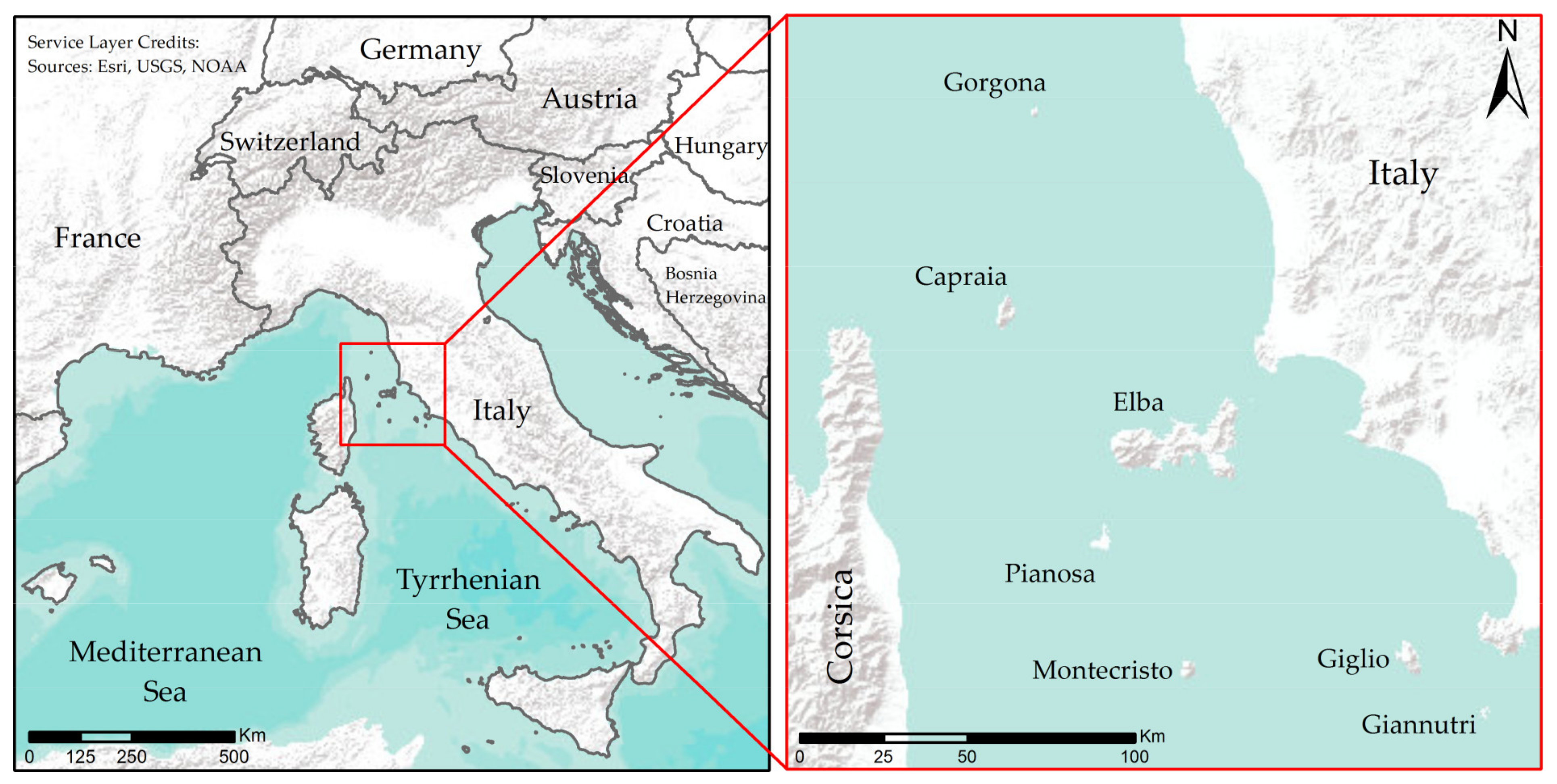
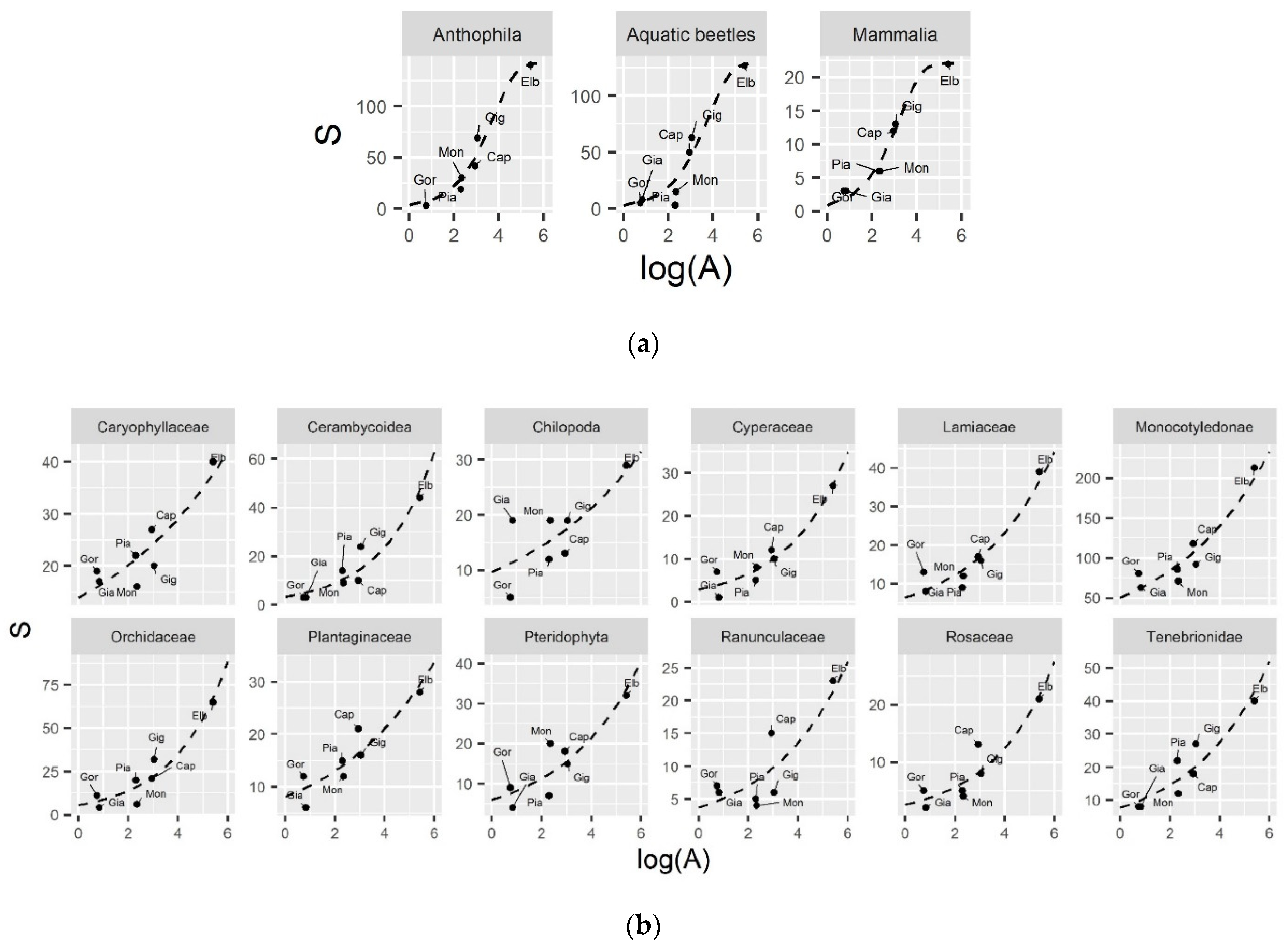
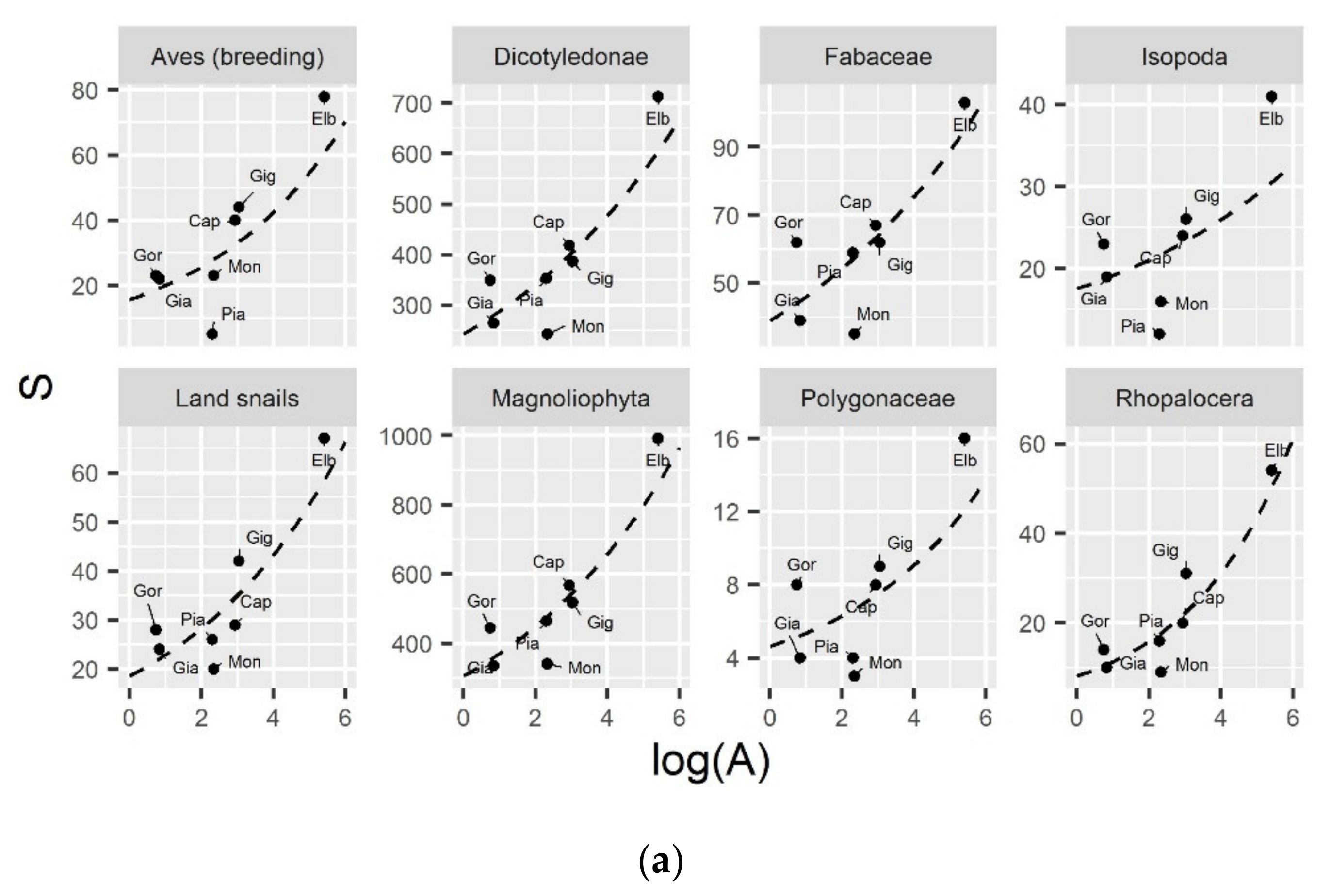
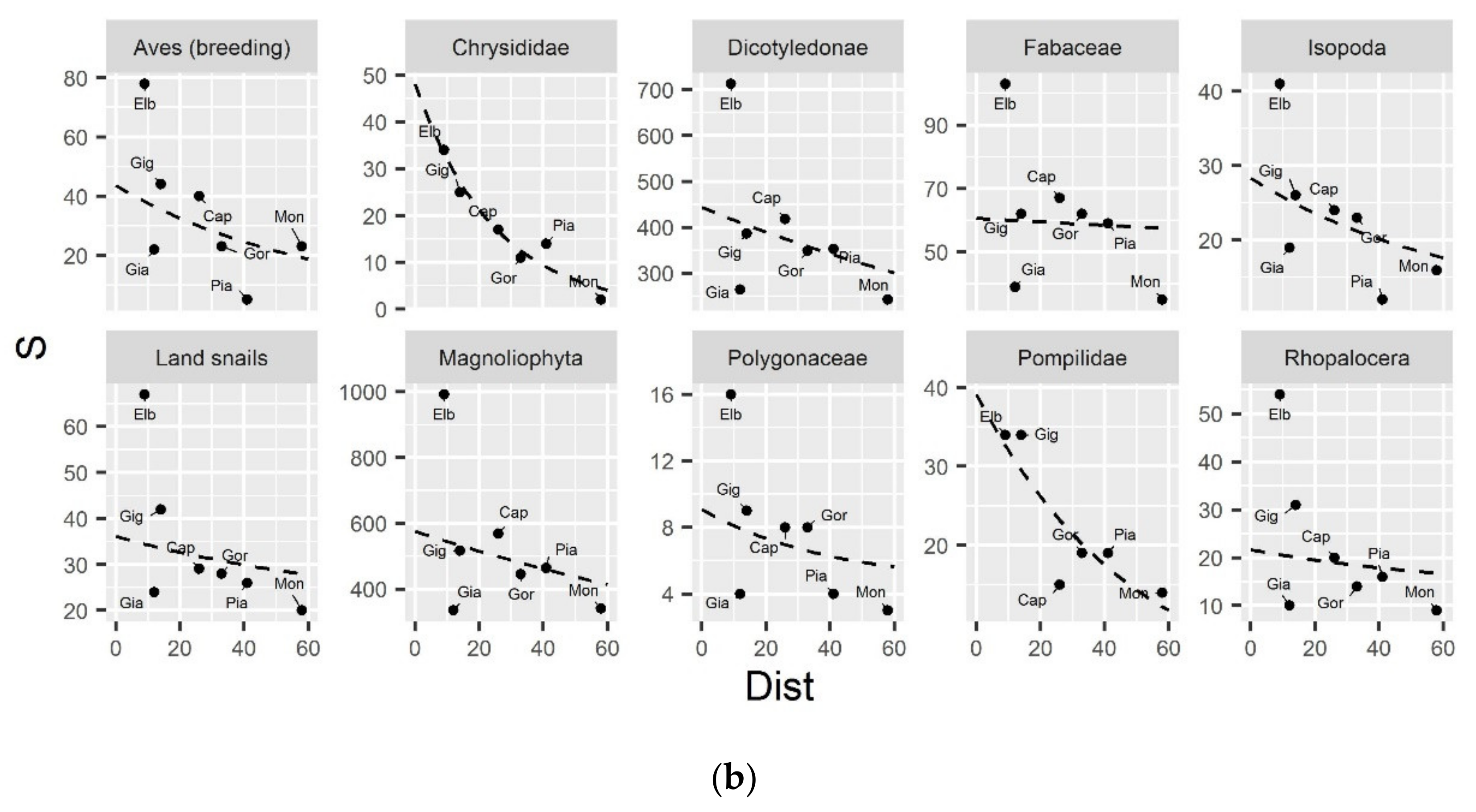
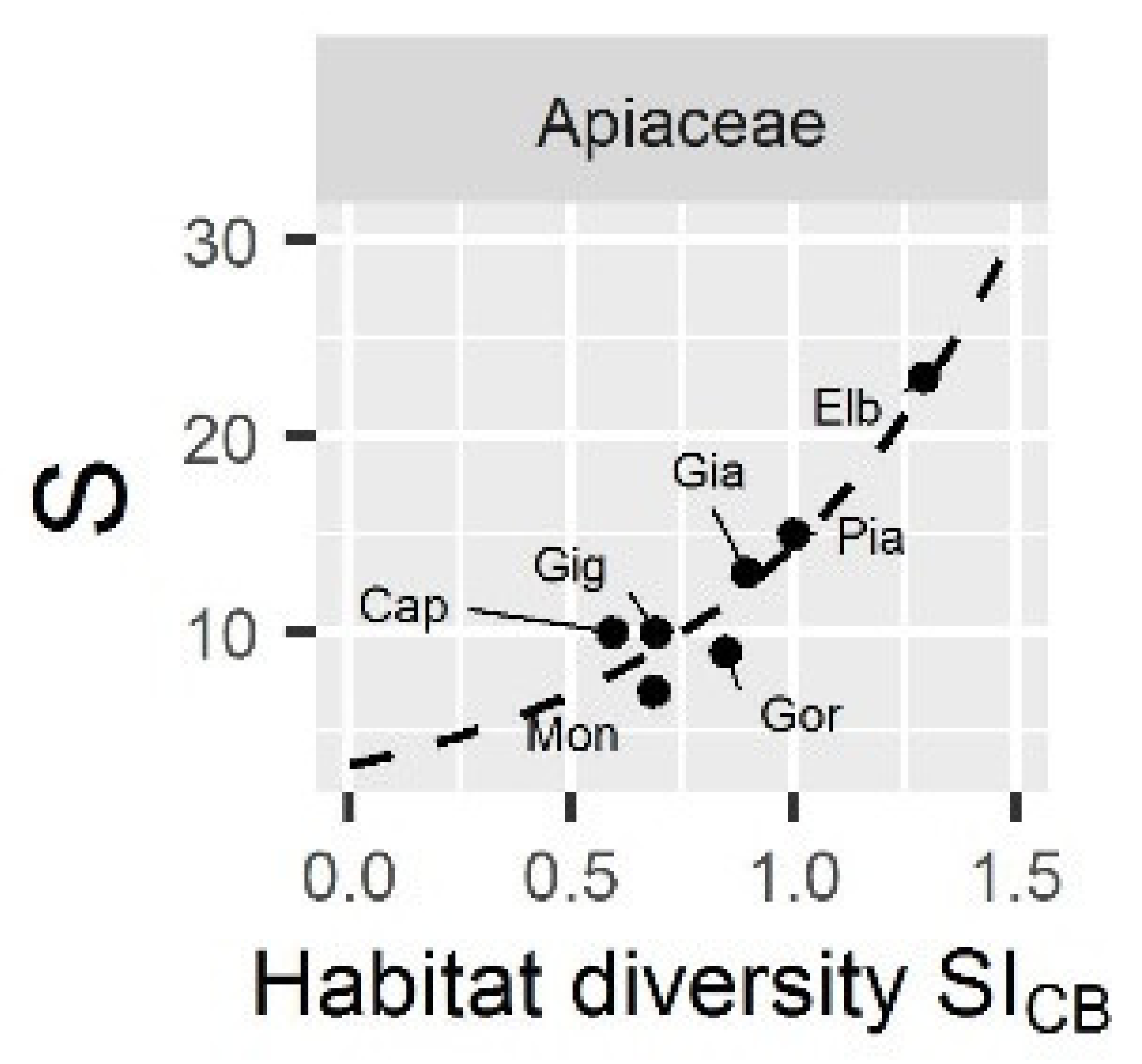
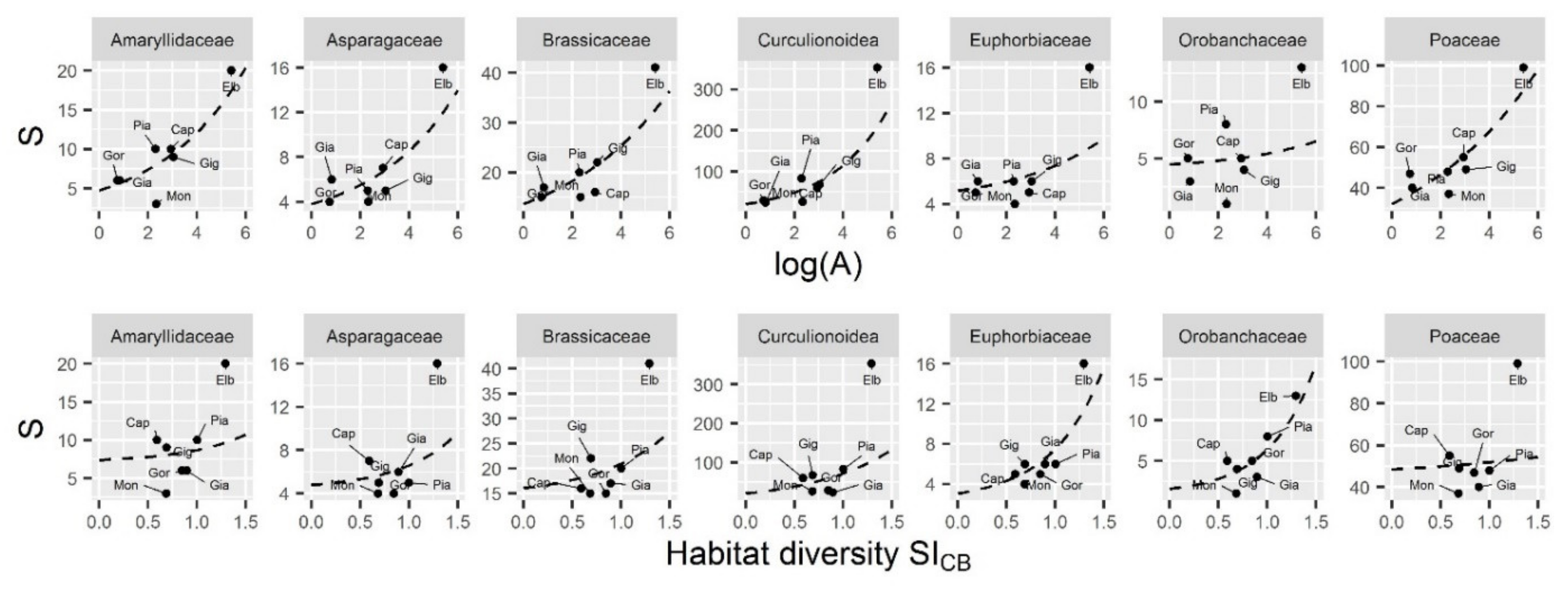
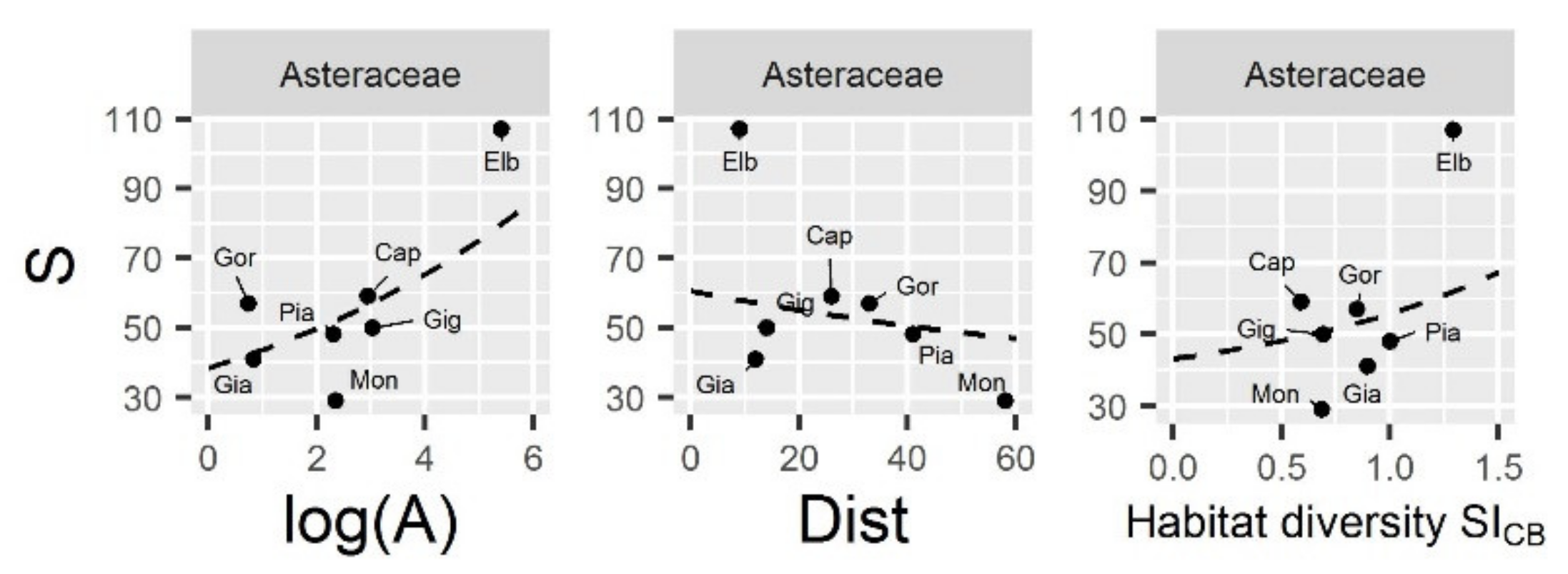
| Taxon | Taxonomic Rank | Minimum and Maximum Number of Species on Islands | Sources |
|---|---|---|---|
| Anthophila | Mixed Families | 3–141 | original unpublished data |
| Aquatic beetles | Mixed Families | 3–127 | Rocchi et al., 2014 [27] |
| Aves (breeding) | Class | 5–78 | Tellini Florenzano et al., 1997 [28]. |
| Cerambycoidea | Super-Family | 3–44 | Ceccolini et al., 2012 [29] |
| Chilopoda | Class | 5–29 | Fattorini et al.,2017 [30] |
| Chrysididae | Family | 2–34 | Fattorini, 2009 [24]; Dapporto et al., 2006 [31] |
| Curculionoidea | Super-Family | 24–353 | Forbicioni et al., 2019 [32] |
| Isopoda | Order | 12–41 | Fattorini et al., 2017 [30] |
| Land snails | Mixed Families | 20–67 | Fattorini, 2009 [24]; Fattorini et al., 2017 [30]; Barbato et al., 2018 [33] |
| Mammalia | Class | 2–22 | Angelici et al., 2009 [34]; Amori et al., 2015 [35]; De Marinis et al., 1996 [36] |
| Pompilidae | Family | 14–34 | Dapporto et al., 2006 [31] |
| Reptilia | Class | 4–12 | Fattorini, 2009 [24]; Fattorini, 2010 [37]; Fattorini et al., 2017 [30] |
| Rhopalocera | Sub-Order | 9–54 | Fattorini, 2009 [24]; Dapporto and Cini, 2007 [23] |
| Tenebrionidae | Family | 8–40 | Fattorini, 2009 [24]; Fattorini, 2010 [37]; Fattorini et al. 2017 [30]; Leo and Forbicioni, 2020 [38] |
| Plants: 28 taxa | Division to Family [39,40] | 1 to 341–11 to 1017 | Chiarucci et al., 2017 [41]; Carta et al., 2018 [42]; original unpublished data |
| Island | Area (km2) | Distance from Tuscan Coastline (km) | Distance from Corsican Coastline (km) | Habitat Diversity (Shannon’s Index) |
|---|---|---|---|---|
| Elba | 223.3 | 9 | 50 | 1.294 |
| Giglio | 20.9 | 14 | 107 | 0.691 |
| Capraia | 18.9 | 51 | 26 | 0.591 |
| Montecristo | 10.4 | 63 | 58 | 0.685 |
| Pianosa | 10.0 | 58 | 41 | 1.002 |
| Giannutri | 2.3 | 12 | 122 | 0.896 |
| Gorgona | 2.1 | 33 | 57 | 0.847 |
| Taxon | Hypothesis | AICc | R2 adj | Supported Hypothesis |
|---|---|---|---|---|
| Anthophila | SAR | 52.25 | 0.959 | ● |
| EQH | 90.32 | 0.941 | ||
| HDH | 69.36 | 0.292 | ||
| SAR + HDH | 90.60 | 0.934 | ||
| Aquatic beetles | SAR | 62.98 | 0.912 | ● |
| EQH | 76.89 | 0.946 | ||
| HDH | 78.81 | 0.151 | ||
| SAR + HDH | 79.90 | 0.918 | ||
| Mammalia | SAR | 28.52 | 0.972 | ● |
| EQH | 39.55 | 0.989 | ||
| HDH | 52.67 | 0.111 | ||
| SAR + HDH | 46.49 | 0.969 |
| Taxon | Estimate | SE | t-Value | Pr(>|t|) | |
|---|---|---|---|---|---|
| Anthophila | Asymptote | 142.3 | 10.48 | 13.57 | <0.001 |
| Area exponent | 0.023 | 0.004 | 5.719 | 0.005 | |
| Aquatic beetles | Asymptote | 128.8 | 14.27 | 9.027 | <0.001 |
| Area exponent | 0.022 | 0.006 | 3.768 | 0.013 | |
| Mammalia | Asymptote | 22.10 | 1.152 | 19.18 | <0.001 |
| Area exponent | 0.039 | 0.004 | 9.121 | <0.001 |
| Intercept | log(Area) | Distance | SICB | ||||||||||||
|---|---|---|---|---|---|---|---|---|---|---|---|---|---|---|---|
| Taxon | Estim. | Pr(>|z|) | Estim. | Pr(>|z|) | Estim. | Pr(>|z|) | Estim. | Pr(>|z|) | df | logLik | AICc | Delta | Weight | R adj | Hypothesis |
| Amaranthaceae | 0.672 | 0.214 | 1.546 | 0.005 | 2 | −14.62 | 36.24 | - | 0.678 | 0.782 | none | ||||
| 1.541 | <0.001 | 0.191 | 0.026 | 2 | −15.93 | 38.87 | 2.627 | 0.182 | 0.483 | ||||||
| 2.061 | <0.001 | 1 | −18.30 | 39.40 | 3.160 | 0.140 | null | ||||||||
| Amaryllidaceae | 1.401 | <0.001 | 0.285 | <0.001 | 2 | −16.27 | 39.53 | - | 0.848 | 0.780 | SAR + HDH | ||||
| 0.760 | 0.130 | 1.613 | 0.002 | 2 | −17.98 | 42.97 | 3.434 | 0.152 | 0.584 | ||||||
| Apiaceae | 1.182 | 0.006 | 1.492 | 0.001 | 2 | −15.95 | 38.90 | - | 1.000 | 0.883 | HDH | ||||
| Asparagaceae | 1.065 | 0.001 | 0.294 | 0.001 | 2 | −14.21 | 35.42 | - | 0.726 | 0.815 | SAR + HDH | ||||
| 0.333 | 0.571 | 1.738 | 0.004 | 2 | −15.19 | 37.37 | 1.953 | 0.274 | 0.649 | ||||||
| Asteraceae | 3.869 | <0.001 | 0.148 | <0.001 | −0.0098 | 0.007 | 3 | −28.41 | 70.82 | - | 0.354 | 0.667 | EQH + HDH | ||
| 3.491 | <0.001 | 0.194 | <0.001 | 2 | −32.21 | 71.42 | 0.600 | 0.262 | 0.622 | ||||||
| 3.077 | <0.001 | 0.126 | 0.002 | 0.676 | 0.009 | 3 | −28.76 | 71.51 | 0.695 | 0.250 | 0.683 | ||||
| 3.470 | <0.001 | −0.0101 | 0.005 | 0.914 | <0.001 | 3 | −29.84 | 73.67 | 2.856 | 0.085 | 0.567 | ||||
| 2.940 | <0.001 | 1.217 | <0.001 | 2 | −33.87 | 74.73 | 3.915 | 0.050 | 0.539 | ||||||
| Aves (breeding) | 3.224 | <0.001 | 0.239 | <0.001 | −0.0164 | 0.002 | 3 | −30.37 | 74.74 | - | 0.863 | 0.805 | EQH | ||
| 2.578 | <0.001 | 0.324 | <0.001 | 2 | −35.71 | 78.43 | 3.687 | 0.137 | 0.737 | ||||||
| Boraginaceae | 2.132 | <0.001 | 1 | −15.91 | 34.62 | - | 0.459 | null | none | ||||||
| 2.485 | <0.001 | −0.0137 | 0.109 | 2 | −14.55 | 36.10 | 1.472 | 0.220 | 0.544 | ||||||
| 1.777 | <0.001 | 0.133 | 0.115 | 2 | −14.71 | 36.42 | 1.798 | 0.187 | 0.582 | ||||||
| 1.477 | 0.004 | 0.746 | 0.181 | 2 | −15.05 | 37.10 | 2.473 | 0.133 | 0.377 | ||||||
| Brassicaceae | 2.429 | <0.001 | 0.220 | <0.001 | 2 | −18.84 | 44.68 | - | 0.728 | 0.820 | SAR + HDH | ||||
| 1.821 | <0.001 | 1.362 | <0.001 | 2 | −19.83 | 46.65 | 1.972 | 0.272 | 0.714 | ||||||
| Caryophyllaceae | 2.636 | <0.001 | 0.183 | <0.001 | 2 | −19.00 | 45.01 | - | 1.000 | 0.787 | SAR | ||||
| Cerambycoidea | 1.214 | <0.001 | 0.488 | <0.001 | 2 | −19.41 | 45.83 | - | 1.000 | 0.873 | SAR | ||||
| Chilopoda | 2.270 | <0.001 | 0.197 | 0.001 | 2 | −21.60 | 50.20 | - | 1.000 | 0.502 | SAR | ||||
| Chrysididae | 3.875 | <0.001 | −0.0410 | <0.001 | 2 | −15.48 | 38.97 | - | 1.000 | 0.922 | EQH * | ||||
| Crassulaceae | 1.966 | <0.001 | 1 | −17.04 | 36.88 | - | 0.544 | null | none | ||||||
| 1.475 | <0.001 | 0.181 | 0.045 | 2 | −15.12 | 37.24 | 0.357 | 0.456 | 0.405 | ||||||
| Curculionoidea | 1.967 | <0.001 | 0.429 | <0.001 | 1.235 | <0.001 | 3 | −29.31 | 72.63 | - | 1.000 | 0.985 | SAR + HDH | ||
| Cyperaceae | 1.042 | <0.001 | 0.419 | <0.001 | 2 | −16.80 | 40.59 | - | 1.000 | 0.911 | SAR | ||||
| Dicotyledonae | 5.670 | <0.001 | 0.169 | <0.001 | −0.0065 | <0.001 | 3 | −53.40 | 120.7 | - | 1.000 | 0.826 | EQH | ||
| Euphorbiaceae | 0.219 | 0.708 | 1.879 | 0.001 | 2 | −13.91 | 34.82 | - | 0.642 | 0.836 | SAR + HDH | ||||
| 1.164 | <0.001 | 0.270 | 0.003 | 2 | −14.49 | 35.98 | 1.164 | 0.358 | 0.760 | ||||||
| Fabaceae | 3.655 | <0.001 | 0.169 | <0.001 | 2 | −29.82 | 66.65 | - | 0.855 | 0.624 | EQH | ||||
| 3.895 | <0.001 | 0.140 | <0.001 | −0.0062 | 0.066 | 3 | −28.10 | 70.19 | 3.543 | 0.145 | 0.627 | ||||
| Geraniaceae | 2.197 | <0.001 | 1 | −16.00 | 34.80 | - | 0.761 | null | none | ||||||
| 2.375 | <0.001 | −0.0067 | 0.398 | 2 | −15.63 | 38.26 | 3.467 | 0.134 | 0.003 | ||||||
| 2.092 | <0.001 | 0.041 | 0.627 | 2 | −15.88 | 38.76 | 3.967 | 0.105 | −0.117 | ||||||
| Isopoda | 2.663 | <0.001 | 0.174 | 0.001 | 2 | −22.13 | 51.25 | - | 0.479 | 0.561 | EQH | ||||
| 3.564 | <0.001 | −0.0169 | 0.001 | 2 | −22.37 | 51.75 | 0.493 | 0.375 | 0.393 | ||||||
| 3.112 | <0.001 | 0.121 | 0.025 | −0.0119 | 0.035 | 3 | −19.81 | 53.63 | 2.372 | 0.146 | 0.727 | ||||
| Juncaceae | 1.872 | <0.001 | 1 | −15.64 | 34.27 | - | 0.550 | 0.000 | none | ||||||
| 2.390 | <0.001 | −0.0187 | 0.075 | 2 | −13.96 | 35.92 | 1.643 | 0.242 | 0.136 | ||||||
| 1.296 | 0.001 | 0.193 | 0.075 | 2 | −14.11 | 36.22 | 1.951 | 0.208 | 0.152 | ||||||
| Lamiaceae | 1.863 | <0.001 | 0.321 | <0.001 | 2 | −18.07 | 43.13 | - | 1.000 | 0.903 | SAR | ||||
| Land snails | 2.868 | <0.001 | 0.234 | <0.001 | 2 | −23.28 | 53.55 | - | 0.612 | 0.787 | EQH | ||||
| 3.318 | <0.001 | 0.177 | <0.001 | −0.0116 | 0.016 | 3 | −20.23 | 54.47 | 0.914 | 0.388 | 0.909 | ||||
| Magnoliophyta | 5.872 | <0.001 | 0.192 | <0.001 | −0.0055 | <0.001 | 3 | −58.40 | 130.8 | - | 1.000 | 0.871 | EQH | ||
| Monocotyledonae | 3.925 | <0.001 | 0.255 | <0.001 | 2 | −30.48 | 67.96 | - | 1.000 | 0.890 | SAR | ||||
| Orchidaceae | 1.698 | <0.001 | 0.464 | <0.001 | 2 | −24.57 | 56.13 | - | 1.000 | 0.889 | SAR | ||||
| Orobanchaceae | −0.259 | 0.694 | 2.157 | 0.001 | 2 | −14.46 | 35.92 | - | 0.814 | 0.760 | SAR + HDH | ||||
| 0.920 | 0.010 | 0.281 | 0.005 | 2 | −15.94 | 38.87 | 2.953 | 0.186 | 0.539 | ||||||
| Papaveraceae | 2.358 | <0.001 | 1 | −16.33 | 35.47 | - | 0.762 | 0.000 | none | ||||||
| 1.995 | <0.001 | 0.418 | 0.413 | 2 | −16.01 | 39.01 | 3.543 | 0.130 | 0.024 | ||||||
| 2.464 | <0.001 | −0.0039 | 0.587 | 2 | −16.18 | 39.37 | 3.900 | 0.108 | −0.103 | ||||||
| Plantaginaceae | 2.088 | <0.001 | 0.239 | <0.001 | 2 | −17.81 | 42.61 | - | 1.000 | 0.799 | SAR | ||||
| Poaceae | 3.450 | <0.001 | 0.194 | <0.001 | 2 | −24.52 | 56.04 | - | 0.841 | 0.805 | SAR + HDH | ||||
| 3.146 | <0.001 | 0.144 | <0.001 | 0.500 | 0.057 | 3 | −22.69 | 59.37 | 3.328 | 0.159 | 0.870 | ||||
| Polygonaceae | 1.269 | <0.001 | 0.262 | 0.003 | 2 | −16.22 | 39.45 | - | 0.675 | 0.640 | EQH | ||||
| 2.614 | <0.001 | −0.0249 | 0.012 | 2 | −16.95 | 40.91 | 1.460 | 0.325 | 0.304 | ||||||
| Pompilidae | 3.667 | <0.001 | −0.0201 | <0.001 | 2 | −16.95 | 41.90 | - | 1.000 | 0.709 | EQH * | ||||
| Pteridophyta | 1.788 | <0.001 | 0.319 | <0.001 | 2 | −20.08 | 47.16 | - | 0.779 | 0.755 | EQH | ||||
| Ranunculaceae | 1.300 | <0.001 | 0.326 | <0.001 | 2 | −18.33 | 43.67 | - | 1.000 | 0.687 | SAR | ||||
| Reptilia | 1.218 | <0.001 | 0.216 | 0.025 | 2 | −13.22 | 33.45 | - | 0.410 | 0.812 | none | ||||
| 1.815 | <0.001 | 1 | −15.63 | 34.06 | 0.609 | 0.302 | 0.000 | ||||||||
| 0.641 | 0.292 | 1.316 | 0.038 | 2 | −13.58 | 34.16 | 0.708 | 0.288 | 0.696 | ||||||
| Rhopalocera | 2.035 | <0.001 | 0.360 | <0.001 | 2 | −21.48 | 49.95 | - | 0.693 | 0.869 | EQH | ||||
| 2.623 | <0.001 | 0.281 | <0.001 | −0.0146 | 0.024 | 3 | −18.79 | 51.58 | 1.632 | 0.307 | 0.934 | ||||
| Rosaceae | 0.925 | 0.003 | 0.398 | <0.001 | 2 | −15.69 | 38.38 | - | 1.000 | 0.832 | SAR | ||||
| Rubiaceae | 2.449 | <0.001 | 1 | −18.00 | 38.79 | - | 0.390 | 0.000 | none | ||||||
| 2.090 | <0.001 | 0.134 | 0.062 | 2 | −16.31 | 39.63 | 0.835 | 0.257 | 0.538 | ||||||
| 2.752 | <0.001 | −0.0117 | 0.105 | 2 | −16.61 | 40.23 | 1.437 | 0.190 | 0.307 | ||||||
| 1.782 | <0.001 | 0.760 | 0.110 | 2 | −16.76 | 40.53 | 1.737 | 0.163 | 0.332 | ||||||
| Tenebrionidae | 2.042 | <0.001 | 0.318 | <0.001 | 2 | −19.47 | 45.93 | - | 1.000 | 0.824 | SAR | ||||
| Taxon | Driver | Estimate | SE | SE adj | z-Value | Pr(>|z|) | Importance |
|---|---|---|---|---|---|---|---|
| Amaryllidaceae | Intercept | 1.304 | 0.396 | 0.482 | 2.706 | 0.007 | - |
| Log(Area) | 0.242 | 0.125 | 0.139 | 1.739 | 0.082 | 0.848 | |
| SICB | 0.246 | 0.613 | 0.636 | 0.386 | 0.700 | 0.152 | |
| Apiaceae | Intercept | 1.182 | 0.429 | - | 2.752 | 0.006 | - |
| SICB | 1.492 | 0.443 | - | 3.369 | 0.001 | - | |
| Asparagaceae | Intercept | 0.865 | 0.528 | 0.634 | 1.364 | 0.173 | - |
| Log(Area) | 0.213 | 0.152 | 0.166 | 1.289 | 0.198 | 0.726 | |
| SICB | 0.475 | 0.835 | 0.877 | 0.542 | 0.588 | 0.274 | |
| Asteraceae | Intercept | 3.492 | 0.373 | 0.410 | 8.510 | <0.001 | - |
| Distance | −0.0043 | 0.005 | 0.006 | 0.726 | 0.468 | 0.865 | |
| Log(Area) | 0.135 | 0.068 | 0.075 | 1.803 | 0.071 | 0.438 | |
| SICB | 0.307 | 0.434 | 0.460 | 0.668 | 0.504 | 0.384 | |
| Aves (breeding) | Intercept | 3.136 | 0.316 | 0.387 | 8.100 | <0.001 | - |
| Distance | −0.0142 | 0.007 | 0.009 | 1.602 | 0.109 | 1.000 | |
| Log(Area) | 0.250 | 0.053 | 0.069 | 3.613 | <0.001 | 0.863 | |
| Brassicaceae | Intercept | 2.264 | 0.355 | 0.405 | 5.586 | <0.001 | - |
| Log(Area) | 0.160 | 0.108 | 0.114 | 1.406 | 0.160 | 0.728 | |
| SICB | 0.370 | 0.632 | 0.650 | 0.569 | 0.569 | 0.272 | |
| Caryophyllaceae | Intercept | 2.636 | 0.167 | - | 15.75 | <0.001 | - |
| Log(Area) | 0.183 | 0.050 | - | 3.649 | <0.001 | - | |
| Cerambycoidea | Intercept | 1.214 | 0.244 | - | 4.974 | <0.001 | - |
| Log(Area) | 0.488 | 0.060 | - | 8.110 | <0.001 | - | |
| Chilopoda | Intercept | 2.270 | 0.198 | - | 11.45 | <0.001 | - |
| Log(Area) | 0.197 | 0.059 | - | 3.333 | 0.001 | - | |
| Chrysididae | Intercept | 3.875 | 0.184 | - | 21.06 | <0.001 | - |
| Distance | −0.0410 | 0.007 | - | −5.505 | <0.001 | - | |
| Curculionoidea | Intercept | 1.967 | 0.166 | - | 11.82 | <0.001 | - |
| SICB | 1.235 | 0.248 | - | 4.986 | <0.001 | - | |
| Log(Area) | 0.429 | 0.041 | - | 10.43 | <0.001 | - | |
| Cyperaceae | Intercept | 1.042 | 0.288 | - | 3.621 | <0.001 | - |
| Log(Area) | 0.419 | 0.074 | - | 5.670 | <0.001 | - | |
| Dicotyledonae | Intercept | 5.670 | 0.065 | - | 86.97 | <0.001 | - |
| Distance | −0.0065 | 0.001 | - | −4.795 | <0.001 | - | |
| Log(Area) | 0.169 | 0.013 | - | 12.53 | <0.001 | - | |
| Euphorbiaceae | Intercept | 0.558 | 0.679 | 0.803 | 0.694 | 0.487 | - |
| SICB | 1.205 | 1.017 | 1.093 | 1.103 | 0.270 | 0.642 | |
| Log(Area) | 0.097 | 0.140 | 0.147 | 0.656 | 0.512 | 0.358 | |
| Fabaceae | Intercept | 3.689 | 0.141 | 0.173 | 21.27 | <0.001 | - |
| Log(Area) | 0.165 | 0.033 | 0.043 | 3.822 | <0.001 | 1.000 | |
| Distance | −0.0009 | 0.003 | 0.003 | 0.317 | 0.751 | 0.145 | |
| Isopoda | Intercept | 3.066 | 0.450 | 0.477 | 6.431 | <0.001 | - |
| Log(Area) | 0.101 | 0.090 | 0.097 | 1.044 | 0.297 | 0.625 | |
| Distance | −0.0081 | 0.009 | 0.009 | 0.851 | 0.395 | 0.521 | |
| Lamiaceae | Intercept | 1.863 | 0.213 | - | 8.765 | <0.001 | - |
| Log(Area) | 0.321 | 0.058 | - | 5.530 | <0.001 | - | |
| Land snails | Intercept | 3.042 | 0.282 | 0.328 | 9.277 | <0.001 | - |
| Log(Area) | 0.212 | 0.051 | 0.064 | 3.307 | 0.001 | 1.000 | |
| Distance | −0.0045 | 0.006 | 0.007 | 0.637 | 0.524 | 0.388 | |
| Magnoliophyta | Intercept | 5.872 | 0.057 | - | 102.4 | <0.001 | - |
| Distance | −0.0055 | 0.001 | - | −4.686 | <0.001 | - | |
| Log(Area) | 0.192 | 0.012 | - | 16.38 | <0.001 | - | |
| Monocotyledonae | Intercept | 3.925 | 0.081 | - | 48.15 | <0.001 | - |
| Log(Area) | 0.255 | 0.023 | - | 10.933 | <0.001 | - | |
| Orchidaceae | Intercept | 1.698 | 0.197 | - | 8.626 | <0.001 | - |
| Log(Area) | 0.464 | 0.049 | - | 9.437 | <0.001 | - | |
| Orobanchaceae | Intercept | −0.040 | 0.765 | 0.924 | 0.043 | 0.966 | - |
| SICB | 1.756 | 1.024 | 1.139 | 1.542 | 0.123 | 0.814 | |
| Log(Area) | 0.052 | 0.118 | 0.123 | 0.425 | 0.671 | 0.186 | |
| Plantaginaceae | Intercept | 2.088 | 0.208 | - | 10.06 | <0.001 | - |
| Log(Area) | 0.239 | 0.060 | - | 3.989 | <0.001 | - | |
| Poaceae | Intercept | 3.401 | 0.169 | 0.205 | 16.57 | <0.001 | - |
| Log(Area) | 0.186 | 0.039 | 0.049 | 3.770 | <0.001 | 1.000 | |
| SICB | 0.080 | 0.211 | 0.236 | 0.338 | 0.736 | 0.159 | |
| Polygoceae | Intercept | 1.707 | 0.694 | 0.736 | 2.319 | 0.020 | - |
| Log(Area) | 0.176 | 0.142 | 0.154 | 1.145 | 0.252 | 0.675 | |
| Distance | −0.0081 | 0.013 | 0.014 | 0.587 | 0.558 | 0.325 | |
| Pompilidae | Intercept | 3.667 | 0.167 | - | 22.00 | <0.001 | - |
| Distance | −0.0201 | 0.006 | - | −3.532 | <0.001 | - | |
| Pteridophyta | Intercept | 1.787 | 0.221 | - | 8.080 | <0.001 | - |
| Log(Area) | 0.319 | 0.060 | - | 5.272 | <0.001 | - | |
| Ranunculaceae | Intercept | 1.300 | 0.280 | - | 4.639 | <0.001 | - |
| Log(Area) | 0.326 | 0.076 | - | 4.277 | <0.001 | - | |
| Rhopalocera | Intercept | 2.215 | 0.355 | 0.414 | 5.354 | <0.001 | - |
| Log(Area) | 0.336 | 0.064 | 0.079 | 4.225 | <0.001 | 1.000 | |
| Distance | −0.0045 | 0.008 | 0.008 | 0.531 | 0.595 | 0.307 | |
| Rosaceae | Intercept | 0.925 | 0.312 | - | 2.966 | 0.003 | - |
| Log(Area) | 0.398 | 0.081 | - | 4.913 | <0.001 | - | |
| Tenebrionidae | Intercept | 2.042 | 0.195 | - | 10.47 | <0.001 | - |
| Log(Area) | 0.318 | 0.053 | - | 5.962 | <0.001 | - |
Publisher’s Note: MDPI stays neutral with regard to jurisdictional claims in published maps and institutional affiliations. |
© 2021 by the authors. Licensee MDPI, Basel, Switzerland. This article is an open access article distributed under the terms and conditions of the Creative Commons Attribution (CC BY) license (https://creativecommons.org/licenses/by/4.0/).
Share and Cite
Ruzzier, E.; Forbicioni, L.; Gentili, R.; Tormen, N.; Dondina, O.; Orioli, V.; Bani, L. From Island Biogeography to Conservation: A Multi-Taxon and Multi-Taxonomic Rank Approach in the Tuscan Archipelago. Land 2021, 10, 486. https://doi.org/10.3390/land10050486
Ruzzier E, Forbicioni L, Gentili R, Tormen N, Dondina O, Orioli V, Bani L. From Island Biogeography to Conservation: A Multi-Taxon and Multi-Taxonomic Rank Approach in the Tuscan Archipelago. Land. 2021; 10(5):486. https://doi.org/10.3390/land10050486
Chicago/Turabian StyleRuzzier, Enrico, Leonardo Forbicioni, Rodolfo Gentili, Nicola Tormen, Olivia Dondina, Valerio Orioli, and Luciano Bani. 2021. "From Island Biogeography to Conservation: A Multi-Taxon and Multi-Taxonomic Rank Approach in the Tuscan Archipelago" Land 10, no. 5: 486. https://doi.org/10.3390/land10050486
APA StyleRuzzier, E., Forbicioni, L., Gentili, R., Tormen, N., Dondina, O., Orioli, V., & Bani, L. (2021). From Island Biogeography to Conservation: A Multi-Taxon and Multi-Taxonomic Rank Approach in the Tuscan Archipelago. Land, 10(5), 486. https://doi.org/10.3390/land10050486









